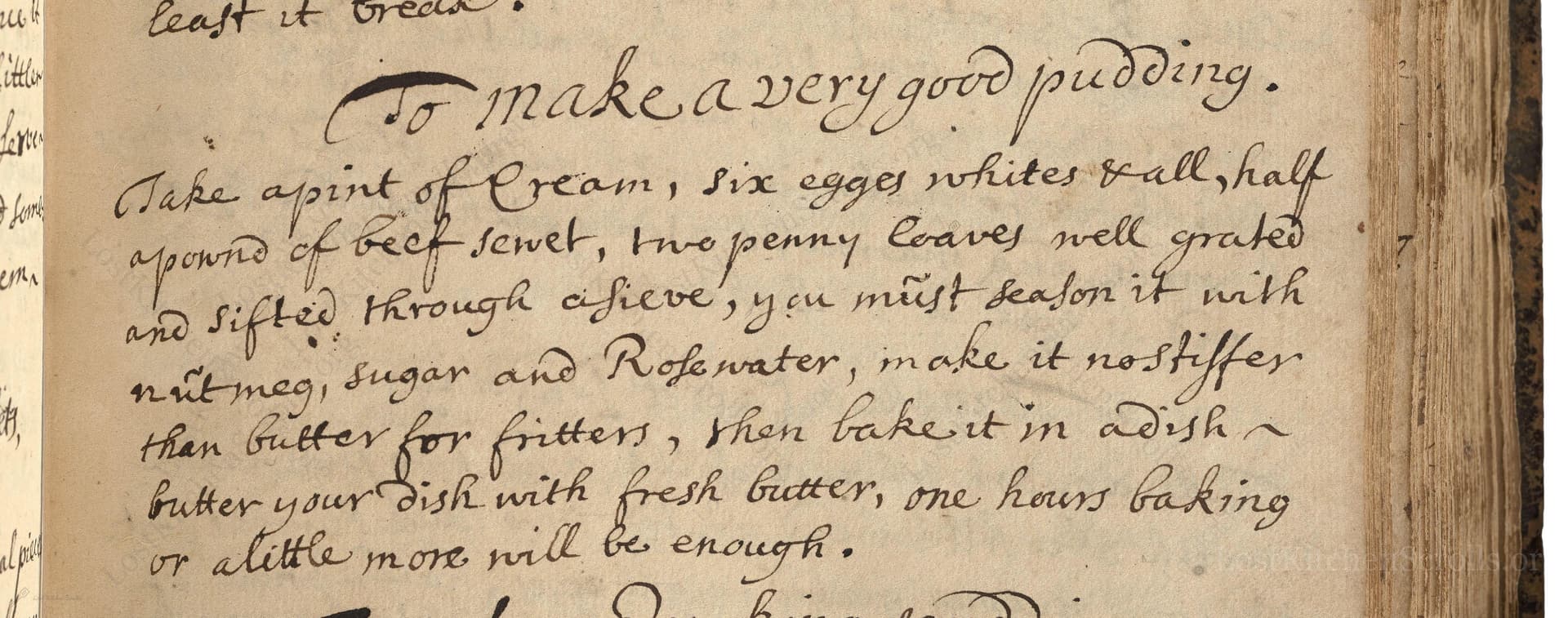To Make A Very Good Pudding
From the treasured pages of Cookbook
Unknown Author

To Make A Very Good Pudding
"Take a pint of Cream, six egges whites & all, half a pound of beef sewet, two penny loaves well grated and sifted through a sieve, you must season it with nutmeg, sugar and Rosewater, make it no stiffer than butterr for fritters, then bake it in dish butterr your dish with fresh butterr, one hours baking or a little more will be enough."
Note on the Original Text
The recipe is written in the casual, narrative style typical of early 18th-century manuscripts—directions are conversational, ingredient quantities blend familiar weights with verbal cues, and exact measurements or temperatures are rare. Words like 'penny loaves' refer to small standard breads available at the time, and terms such as 'sewet' (suet) reflect older spellings. Instructions rely on familiarity with the look and feel of batters—'no stiffer than butter for fritters'—making interpretation an art in itself. This charming imprecision is a hallmark of historical recipes.

Title
Cookbook (1706)
You can also click the book image above to peruse the original tome
Writer
Unknown
Era
1706
Publisher
Unknown
Background
Step back to the early 18th century with this charming culinary collection, brimming with period recipes that tantalize the tastebuds and offer a delicious glimpse into historic kitchens.
Kindly made available by
Folger Shakespeare Library
This recipe dates to approximately 1706, reflecting early 18th-century English domestic cookery. Puddings of this period ranged from savory to sweet, often relying on simple, available ingredients such as bread, cream, and suet to create comforting, hearty dishes. The inclusion of rosewater and nutmeg hints at the lingering influence of medieval and Renaissance flavors, prized for their aromatic qualities. Recipes like this were commonly written for household cooks and gently guided them toward a pleasing balance of texture and flavor, relying on visual and tactile cues rather than precise timings or temperatures.

This pudding would have been made with basic kitchen implements: a large bowl for mixing, a coarse grater for preparing the bread and suet, a sieve for sifting the crumbs, a wooden spoon for stirring, and a well-buttered shallow bake dish (likely earthenware or tin). Baking would have taken place in a hearth oven or a closed beehive oven, monitored by intuition and trained experience rather than thermometers.
Prep Time
20 mins
Cook Time
1 hr 5 mins
Servings
8
We've done our best to adapt this historical recipe for modern kitchens, but some details may still need refinement. We warmly welcome feedback from fellow cooks and culinary historians — your insights support the entire community!
Ingredients
- 2 1/3 cups heavy cream
- 6 large eggs, whole
- 8 oz beef suet (or 8 oz unsalted butter, grated, as substitute)
- 4 1/4 oz white bread, finely grated (approx. two small rolls)
- ½ tsp grated nutmeg
- 1/2 cup granulated sugar
- 1 tbsp rosewater
- Butter (for greasing dish, about 1 tbsp)
Instructions
- Begin by preheating your oven to 350°F (180°C).
- In a large bowl, whisk together 2 1/3 cups of heavy cream and 6 large eggs until well combined.
- Finely chop 8 oz of beef suet, or substitute with the same amount of chilled, grated unsalted butter if suet is unavailable.
- Add this to the mix.
- Grate two small white bread rolls (about 4 1/4 oz total) and sift to create fine breadcrumbs.
- Stir the breadcrumbs into the wet ingredients.
- Flavor the batter with ½ teaspoon grated nutmeg, 1/2 cup of sugar, and 1 tablespoon of rosewater.
- The mixture should have the consistency of a thick batter, similar to that for fritters.
- Butter a baking dish (roughly 8 inches square) with fresh unsalted butter.
- Pour in the pudding mixture, spreading evenly.
- Bake in the preheated oven for about 60–70 minutes, until golden and just set.
- Let cool slightly before serving.
Estimated Calories
400 per serving
Cooking Estimates
It takes about 20 minutes to prepare the ingredients. The pudding bakes for about 65 minutes. Each serving has around 400 calories. The recipe makes 8 servings.
As noted above, we have made our best effort to translate and adapt this historical recipe for modern kitchens, taking into account ingredients nowadays, cooking techniques, measurements, and so on. However, historical recipes often contain assumptions that require interpretation.
We'd love for anyone to help improve these adaptations. Community contributions are highly welcome. If you have suggestions, corrections, or cooking tips based on your experience with this recipe, please share them below.
Join the Discussion
Rate This Recipe

Den Bockfisch In Einer Fleisch Suppen Zu Kochen
This recipe hails from a German manuscript cookbook compiled in 1696, a time whe...

Die Grieß Nudlen Zumachen
This recipe comes from a rather mysterious manuscript cookbook, penned anonymous...

Ein Boudain
This recipe comes from an anonymous German-language manuscript cookbook from 169...

Ein Gesaltzen Citroni
This recipe, dating from 1696, comes from an extensive anonymous German cookbook...
Browse our complete collection of time-honored recipes



